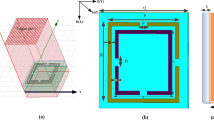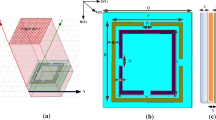Abstract
In this paper, a simple method is presented in order to design complex mpbg structures able to have multiple frequency behaviors. This functionality is all the more important as it is wildly used in modern communication systems. In a first study, a mixed structure composed of a metallic photonic band gap material and a Bragg mirror is designed in order to obtain a wide band-gap. For this structure, the influence of the Bragg mirror on the mpbg is taken into account by considering electrical length. Even if the results are not those expected, this study shows that no correction must be done. The behavior of isolated structures is already enough to evaluate the behavior of the mixed structure. Therefore, basic laws can be drawn. These laws are not only useful to design multiple frequency structures, they can also be used to design mpbg manufactured with a multi layer technology.
Résumé
Cet article présente une méthode simple afin de mettre au point des structures complexes comportant des matériaux métalliques à bande interdite photonique (bip) et ayant notamment des comportements multifréquences intéressants, fonctionnalité ďautant plus importante quelle est largement utilisée dans les systèmes de communication modernes. Dans une première étude, une structure composée ďun bip métallique et ďun miroir de Bragg est mise au point afin ďobtenir un comportement à large bande interdite. Même si les résultats obtenus ne sont pas ceux escomptés, cette étude montre ľintérêt des structures mixtes. En effet, des lois simples sont ensuite exposées, qui permettent de créer des structures multifréquences grâce à ľutilisation de structures simples. Ces lois présentent aussi un intérêt particulièrement important pour la réalisation des bip métalliques en technologie multicouche.
Similar content being viewed by others
References
Yablanovitch (E.), “Inhibited Spontaneous Emission in Solid State Physics and Electronics”,Physical Review Letters,58, n° 20, 1987, pp. 2059–2062.
Brown (E.R.), Parker (C.D.), Yablonovttch (E.), “Radiation properties of a planar antenna on a photonic crystal substrate”,Journal of Opt. Am. Soc.,10, n° 2, Feb. 1993, pp. 404–407.
Poilasne (G.),Pouliguen (P.),Mahdjoubi (K.),Terret (C.),Gelin (Ph.),Desclos (L.), “Experimental radiation pattern of dipole inside metallic photonic band-gap materials”,Microwave and Optical Technology Letters,22, issue 1, July 1999.
Chongjun Jin, Bingying Cheng, Baoyuan Man, Daozhong Zhang, “Two-dimesional metallodielectric photonic crystral with a large band-gap”,Applied Physics Letters,75, n° 9, 30 August 1999, pp. 1201–1203.
Desclos (L.),Madihian (M.),Floc’h (J.M.), “Double frequency patch antennas for multimode applications”,IEEE-APS, Montreal, Canada, July 1997.
Agi (K.),Brown (E.R.),Dill III (C.),Malloy (K.J.), “Design of ultrawideband photonic crystrals for broadband antenna applications”,Electronics Letters,30, n° 25, Dec. 1994
Author information
Authors and Affiliations
Corresponding author
Rights and permissions
About this article
Cite this article
Poilasne, G., Pouliguen, P., Terret, C. et al. A simple way to design complex metallic photonic band-gap structures. Ann. Télécommun. 56, 72–77 (2001). https://doi.org/10.1007/BF03002987
Issue Date:
DOI: https://doi.org/10.1007/BF03002987
Key words
- Periodic structure
- Compound structure
- Energy gap
- Dielectric metal structure
- Bragg reflection
- Reflection coefficient
- Multifrequency operation
- Experimental result
- Manufacturing process




